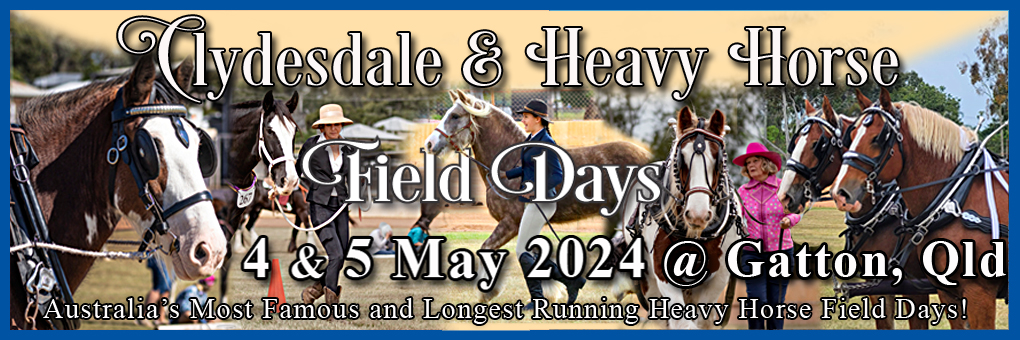The Australian Draught horse is the result of more than a century of mixed breeding of heavy working horses. In 1979 the Australian Draught Horse Stud Book Society was officially formed. Most working horses in Australia in the past were not purebred and, so, the Society was relatively relaxed about its breeding regulations in the early days, today however, there is a strict breed standard in place. Though this does not restrict draught horses competing in field days and shows around Australia. It is horse which was bred for the harsh Australian conditions, and has survived as the dominant breed since the first draught horses were bred in the 1800’s from crosses with those imported at the time of settlement.
The Australian draught has evolved from crossing the four recognised pure breeds of draught horse found in Australia – the Clydesdale, Percheron, Suffolk and the Shire, with some Belgian lines occasionally found. Cross breeding is still conducted to produce working horses and as such, the Australian Draught will carry the characteristics of all those pure breeds. With the feathering on the legs being light to medium depending on bloodlines.
Australia’s early days, the Australian Draught was used to open up this country, with most farms using them as their ploughing horses or the horse to pull the wagons to railway sidings and docks. In the early days, these horses also had the role of taking the family to town or church. People often remember the horses “Grandad” had as being draught horses. There are many recollections of great teams of draught horses working the land or delving bore drains or building dams in rural Australia. Many stories survive of old “Dobin” who was used to carry the family of kids off to school, or “Blossom” who was so quiet the smallest of children could drive them around the paddock. They were as much a part of the family as the working dog.
Of all of the draught breeds available in Australia today, the Australian Draught would be the most popular. There are many that are not registered with the society but whose breeders adhere to the strict breeding guidelines of breeding quality working horses. Horses how can still carry out a full days work.
Like all the other breeds of heavy horses world wide, they suffered a setback to their numbers when the world embraced mechanisation. No longer were they needed to work the land in such numbers, the tractor had put an end to that. Though still today in some parts of QLD, NSW and Tasmania, you can find the odd farmer who has not given up his dream of working the land with these magnificent pieces of Australia’s living history.
The Australian Draught can be found competing in ploughing competitions in all states of Australia. As well as competing in harness classes and led classes. There are still some draught horses used in forestry work log snigging as they can get where the machinery cannot and do not damage the land as much.
The Australian Draught horse come in all solid colours, excessive white is not favoured on the face or body, white below the knee is acceptable. The average height is between 16 and 17.2 hands. They will weigh between 600 and 900kg’s. They are exceptionally intelligent, stron, versatile, have a kind temperament, hard working and are people orientated.
The Australian Draught should have an average sized head with a broad forehead, clear docile eyes and alert ears. Their neck is of medium length and stallions have a well developed crest. The shoulder should be well muscled and blend smoothly into the chest, wither and back area.
The chest, hindquarter and hip are wide and muscled and the forelegs are set well under the body when viewed from the side. The Australian Draught should show good action and length of stride at the walk and trot with the hind foot stepping into or beyond the forefoot mark. They have a hardy constitution and enduring stamina. |
